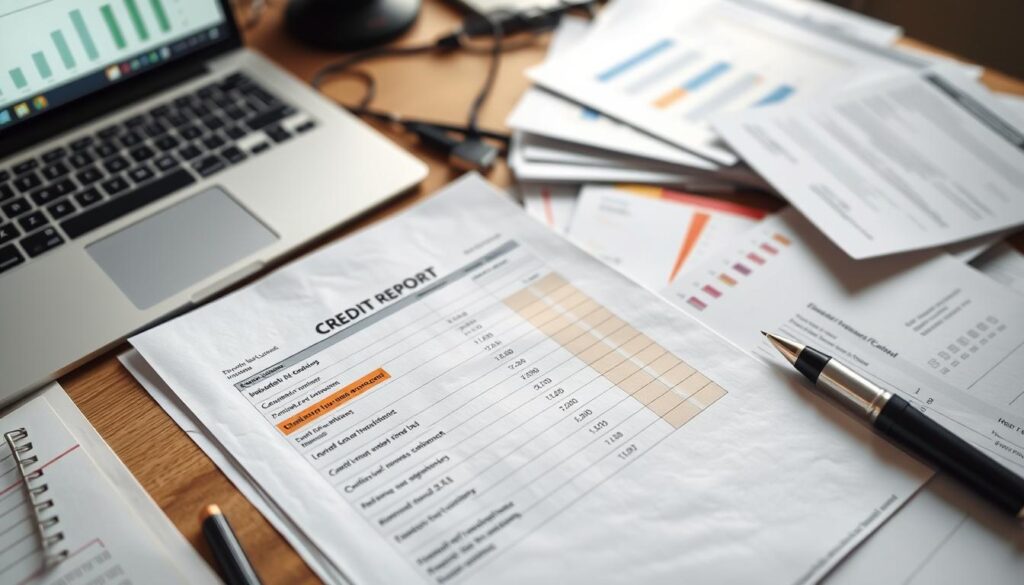A good credit score is crucial in today’s financial world. It can help you get loans, rent homes, and even secure jobs. But mistakes on your credit report can hurt your chances.
Credit repair letters to bureaus can fix these errors. They help you dispute wrong information and improve your credit score.
This guide will teach you how to write effective credit repair letters. You’ll learn to spot errors, gather proof, and boost your financial health.
Key Takeaways
- Understand the importance of credit repair letters in disputing credit report errors
- Learn how to identify and gather evidence for inaccurate information on your credit report
- Discover effective techniques to remove negative items and improve your credit score legally
- Explore credit bureau communication strategies to ensure your disputes are handled promptly
- Leverage your rights under the Fair Credit Reporting Act (FCRA) to exercise your legal protections
Understanding Credit Repair Letters
Credit repair letters are powerful tools for fixing credit report issues. These formal letters to credit bureaus help improve your credit profile and score. They address and resolve problems in your credit report.
What Are Credit Repair Letters?
Credit repair letters highlight errors in your credit report. They ask credit bureaus to investigate and fix these issues. These documents are key to disputing mistakes and starting credit repair.
Why Are They Important?
These letters offer a formal way to tackle credit problems. By sending them to credit bureaus, you can take action.
You can request investigations into wrong information. You can ask for harmful items to be removed. These letters help you communicate with credit bureaus effectively.
Credit repair letters are vital for boosting your credit score. They help maintain a healthy financial profile. They create a paper trail of your credit repair efforts.
credit repair letters to credit bureaus
Credit repair letters are vital for disputing inaccurate information on your credit report. These letters can drive positive changes in your financial health. Mastering this skill can significantly improve your credit score.
Effective letters require proper formatting and the right details. They can be a powerful tool in your journey towards better credit.
The Anatomy of a Successful Credit Repair Letter
A compelling credit repair letter needs several key elements. These components ensure your message is clear and effective.
- Precise Formatting: Adhere to a specific structure, including your contact information, the date, and the credit bureau’s address.
- Detailed Dispute: Clearly identify the inaccurate items on your credit report and provide supporting evidence to substantiate your claims.
- Specific Requests: State the specific actions you would like the credit bureau to take, such as removing the disputed items or investigating the matter further.
- Professional Tone: Maintain a respectful and persuasive tone throughout the letter, avoiding overly emotional language.
Following these guidelines will help your letter stand out. It increases the chances of a positive response from credit bureaus.

“Effective credit repair letters are the foundation of a successful dispute process. Crafting them with care can make all the difference in improving your credit profile.”
Regular communication with credit bureaus is key. Keep monitoring your credit reports and send well-structured letters when needed.
This consistent approach can help you achieve your financial goals. It’s an essential part of maintaining good credit health.
Disputing Credit Report Errors
Wrong info on your credit report can hurt your finances. You can fix these mistakes to show your true creditworthiness. Let’s look at how to spot and fix credit report errors.
Identifying Inaccurate Information
First, review your credit report carefully. Look for any mistakes like accounts you don’t own or wrong balances. Check for late payments that you actually made on time.
These inaccurate information items can harm your credit report and credit score.
Gathering Supporting Documents
After finding errors, collect supporting documents to back up your claims. This may include bank statements or payment records. These supporting documents will make your credit report dispute stronger.
By reviewing your report and gathering proof, you can fight credit report errors effectively. This ensures your financial future is based on correct information.
Stay alert and take steps to keep your credit report accurate. This is key to reaching your money goals.
Remove Inaccurate Items From Your Credit Report
A healthy credit profile is vital for financial success. Removing inaccurate items from your credit report is a crucial step. These errors can hurt your credit score, so it’s important to fix them quickly.
Start by carefully reviewing your credit report for any mistakes. Look for accounts you don’t recognize or incorrect personal details. These errors could be lowering your credit score unnecessarily.
Once you’ve found the issues, begin the dispute process. Here’s how to do it:
- Gather supporting documentation: Collect any receipts, statements, or other evidence that can help prove the inaccuracy of the item in question.
- Draft a credit repair letter: Craft a well-written letter outlining the specific inaccuracies and requesting their removal from your credit report.
- Submit the dispute: Send your letter and supporting documentation to the credit bureaus, either by mail or through their online dispute portals.
- Monitor the process: Follow up on the status of your dispute and ensure the inaccurate items are promptly removed from your credit report.
Fixing these errors can greatly improve your credit score. Credit report disputes are a powerful tool for financial health. Use them wisely to maintain a strong credit profile.
“Protecting the integrity of your credit report is essential for achieving your financial goals.”

Improve Your Credit Score Legally
Boosting your credit score is simpler than you might think. There are legal and ethical ways to enhance your creditworthiness. These methods can unlock better financial opportunities for you.
The Impact of Negative Items
Negative items on your credit report can significantly lower your credit score. These include late payments, collections, and bankruptcies. Addressing these issues through credit repair letters can boost your score.
Disputing inaccurate or unverifiable negative items can help remove them from your report. This can lead to a noticeable increase in your credit score. Better scores make you more attractive to lenders.
| Negative Item | Average Score Impact |
|---|---|
| Late Payment | 60-110 points |
| Collections | 80-100 points |
| Bankruptcy | 150-200 points |
The impact of negative items on your credit score can be substantial. Taking steps to address these issues can improve your financial well-being. You’ll unlock new opportunities and secure a brighter financial future.
“Improving your credit score legally is one of the most empowering actions you can take to secure your financial future.”
Credit Bureau Communication Strategies
Communicating well with credit bureaus is vital for credit repair success. Knowing their dispute methods and writing strong letters can greatly impact results. Let’s explore ways to handle credit bureau interactions and fix report errors.
Mastering the Credit Bureau Dispute Process
Start by learning each bureau’s dispute process. They all have different rules and needs. Research and follow their specific instructions carefully.
This may involve sending dispute letters and proof. You’ll also need to track your case’s progress. Stay organized and persistent throughout the process.
- Understand the credit bureau’s dispute process and timeline
- Gather all relevant documentation to support your dispute
- Submit disputes through the appropriate channels (online, by mail, or by phone)
- Follow up on the status of your dispute and be persistent if necessary
Crafting Persuasive Credit Repair Letters
Your credit repair letters can greatly affect dispute outcomes. Write clear, compelling letters that highlight errors and provide strong evidence. This approach boosts your chances of success.
- Clearly identify the specific inaccuracies in your credit report
- Gather and attach any relevant documents to support your claims
- Use a professional and polite tone, avoiding confrontational language
- Clearly state the desired outcome, such as the removal of the inaccurate item
- Follow up on your letters and be persistent if necessary
Good credit bureau communication is crucial for fixing report errors. Master the dispute process and write strong letters. This approach helps you control your credit and reach financial goals.

“Effective communication with credit bureaus is the cornerstone of successful credit repair.”
Section 609 Letters: Exercising Your FCRA Rights
Section 609 letters are powerful tools for credit repair. They help you use your rights under the Fair Credit Reporting Act (FCRA). The FCRA governs how consumer credit information is handled.
What is the Fair Credit Reporting Act?
The FCRA protects consumers by ensuring accurate and fair credit reports. It gives you the right to dispute wrong information. Credit bureaus must investigate and fix errors they find.
Section 609 lets you request your credit file and challenge incorrect details. Using these letters helps you take charge of your credit repair strategies.
| Key Benefits of Using Section 609 Letters |
|---|
|
Understanding Section 609 letters and the FCRA empowers you to improve your credit report. This can lead to a better credit score and financial health.
By taking action, you can exercise your rights and ensure your credit report is accurate. This proactive approach can make a big difference in your financial future.
Proven Credit Repair Strategies
Credit repair can be challenging, but the right strategies can help you control your financial future. You can choose between DIY credit repair and professional services. Each option has its own benefits.
DIY Credit Repair
DIY credit repair can be cost-effective if you have time and determination. Learning about credit reporting and the Fair Credit Reporting Act is crucial. This knowledge helps you dispute errors and remove negative items.
Taking an active role in improving your credit health can be empowering. It allows you to rebuild your credit profile step by step.
Professional Credit Repair Services
Professional services offer expert guidance and specialized knowledge in credit repair. They use their experience to navigate the process for you. This approach can lead to faster and more comprehensive results.
If you want personalized support and a thorough solution, professional services might be ideal. They can handle complex credit situations effectively.
| DIY Credit Repair | Professional Credit Repair Services |
|---|---|
| Cost-effective | Specialized expertise |
| Hands-on control | Faster results |
| Requires time and effort | Personalized support |
Your choice depends on your preferences, budget, and credit situation complexity. Consider the pros and cons of each approach carefully. This will help you make an informed decision that matches your credit repair goals.

“The key to successful credit repair is to approach it strategically, whether you choose to do it yourself or with the help of professionals.”
Negative Item Removal Techniques
Removing negative items from your credit report can boost your credit score. There are effective ways to dispute and negotiate damaging entries. These methods work for inaccurate information, outdated debts, and unfair derogatory marks.
Disputing Credit Report Errors
Start by reviewing your credit reports for inaccurate or unverifiable information. Once found, initiate a credit report dispute with the appropriate credit bureaus. Submit supporting documents and a detailed letter explaining the discrepancies.
Negotiating Debt Settlements
For legitimate debts, try negotiating a settlement with the creditor. Propose a payment plan or lump-sum settlement in exchange for removing the negative item. Creditors often cooperate to recover outstanding balances and avoid further collection efforts.
Utilizing the “Goodwill Letter”
The goodwill letter is a powerful tool in credit repair. It appeals to the creditor’s empathy, explaining the circumstances behind the delinquency. The letter requests removal of the negative item as a gesture of goodwill.
A well-crafted goodwill letter can sometimes persuade creditors to make an exception. While not guaranteed, it’s worth trying.
These techniques help you control your credit report and improve your credit score. Persistence and attention to detail are key for successful negative item removal.
| Technique | Description | Potential Impact |
|---|---|---|
| Credit Report Dispute | Identifying and disputing inaccurate or unverifiable information on your credit reports | Removal of negative items, leading to an increase in credit score |
| Debt Settlement Negotiation | Negotiating with creditors to settle outstanding debts in exchange for the removal of negative items | Improved credit utilization, which can boost your credit score |
| Goodwill Letter | Appealing to the creditor’s empathy by explaining the circumstances behind a delinquency and requesting the removal of the negative item | Potential removal of the negative item, leading to a positive impact on your credit score |
Use these proven negative item removal techniques to improve your credit report dispute. They can help you achieve a higher credit score improvement.
Debt Validation: Challenging Questionable Debts
Debt validation is a powerful tool for addressing questionable debts on your credit report. It verifies the accuracy and legitimacy of a debt. This process allows you to dispute any inaccurate or unsubstantiated information.
Understanding the Debt Validation Process
Take a proactive approach to debt validation. If you find a suspicious debt on your credit report, act quickly. Send a written request to the credit bureau and debt collector to start the process.
The process typically involves the following steps:
- Identify the questionable debt: Carefully review your credit report to pinpoint any debts that you believe are inaccurate or unverifiable.
- Send a debt validation letter: Compose a letter requesting that the credit bureau and the debt collector validate the debt, providing specific details about why you believe the debt is invalid.
- Wait for a response: The credit bureau and the debt collector have 30 days to respond to your request and provide the necessary documentation to verify the debt.
- Dispute the debt: If the credit bureau or the debt collector is unable to provide the required documentation, you can dispute the debt, which may result in its removal from your credit report.
Use debt validation to challenge questionable debts and improve your credit report dispute. This process can help you take control of your financial future.
“Debt validation is a powerful tool in the credit repair toolkit, empowering consumers to take control of their financial future.”
Approach debt validation with diligence and persistence. Follow the proper steps and provide necessary documentation. This can help you effectively challenge debt validation issues and repair your credit.
Building Positive Credit History
A positive credit history is key to improving your credit score. It opens doors to better financial opportunities. By using smart credit repair techniques, you can shape your financial future.
Timely payments are crucial for building good credit. Payment history is the single most important factor contributing to your credit score. Pay your bills on time every month to show lenders you’re reliable.
Keep your credit card balances low compared to your credit limits. This is called maintaining a low credit utilization ratio. It shows lenders you’re a responsible borrower who doesn’t rely heavily on credit.
Having different types of credit can strengthen your credit profile. Having a variety of credit accounts, such as credit cards, installment loans, and mortgages, can demonstrate your ability to manage different types of credit responsibly.
Building good credit takes time and effort. Stick to credit repair strategies and make smart financial choices. Your credit score will improve, opening new doors to financial success.
“The journey to a healthy credit score is a marathon, not a sprint. Stay the course, be diligent, and you’ll see the rewards of your efforts over time.”
Monitoring Your Credit Reports
Keeping a healthy credit profile requires ongoing effort. Regular credit report checks are vital for maintaining your improved credit standing. Stay alert to address new issues and protect your credit from potential threats.
By staying vigilant, you can safeguard your credit’s progress. This proactive approach helps you tackle problems before they harm your credit score.
Staying Vigilant After Repairs
The work isn’t over once you’ve fixed credit report issues. Credit report monitoring should be part of your regular financial routine. This helps you spot and solve new problems quickly.
Regular checks prevent issues from hurting your credit score. It’s a key part of maintaining your improved credit standing.
- Review your credit reports from all three major bureaus (Experian, Equifax, and TransUnion) at least once a quarter.
- Carefully examine each report for any new inaccuracies, fraudulent activity, or changes to your credit history.
- Dispute any errors or questionable items with the respective credit bureau(s) promptly.
- Monitor your credit score regularly to ensure it continues to improve or maintain its positive trajectory.
Stay alert and tackle issues quickly to protect your credit repair progress. This approach helps maintain a strong, ongoing credit maintenance strategy.
Regular monitoring safeguards your improved credit standing. It’s a crucial step in your long-term financial health.
| Benefit | Importance |
|---|---|
| Early detection of errors | Allows you to address inaccuracies before they cause further damage to your credit |
| Identifying fraudulent activity | Helps you quickly address identity theft and prevent further financial harm |
| Monitoring credit score changes | Enables you to track the ongoing impact of your credit repair efforts |
“Staying on top of your credit reports is crucial for maintaining a healthy financial future. Regular monitoring allows you to quickly address any issues and protect the progress you’ve made through credit repair.”
Common Mistakes to Avoid
Credit repair can be tricky. Knowing common pitfalls helps improve your credit score. A major mistake is not disputing wrong info on your credit report.
Don’t assume credit bureaus fix errors automatically. You must take action. Review your reports carefully. Find any mistakes. Send detailed letters to credit bureaus with proof.
Another error is ignoring credit reports after initial fixes. Credit repair needs ongoing attention. Stay alert and check your reports regularly. Look for new issues that pop up.
Keep a proactive approach. This ensures your credit score keeps improving. Stay on track with your credit goals.

